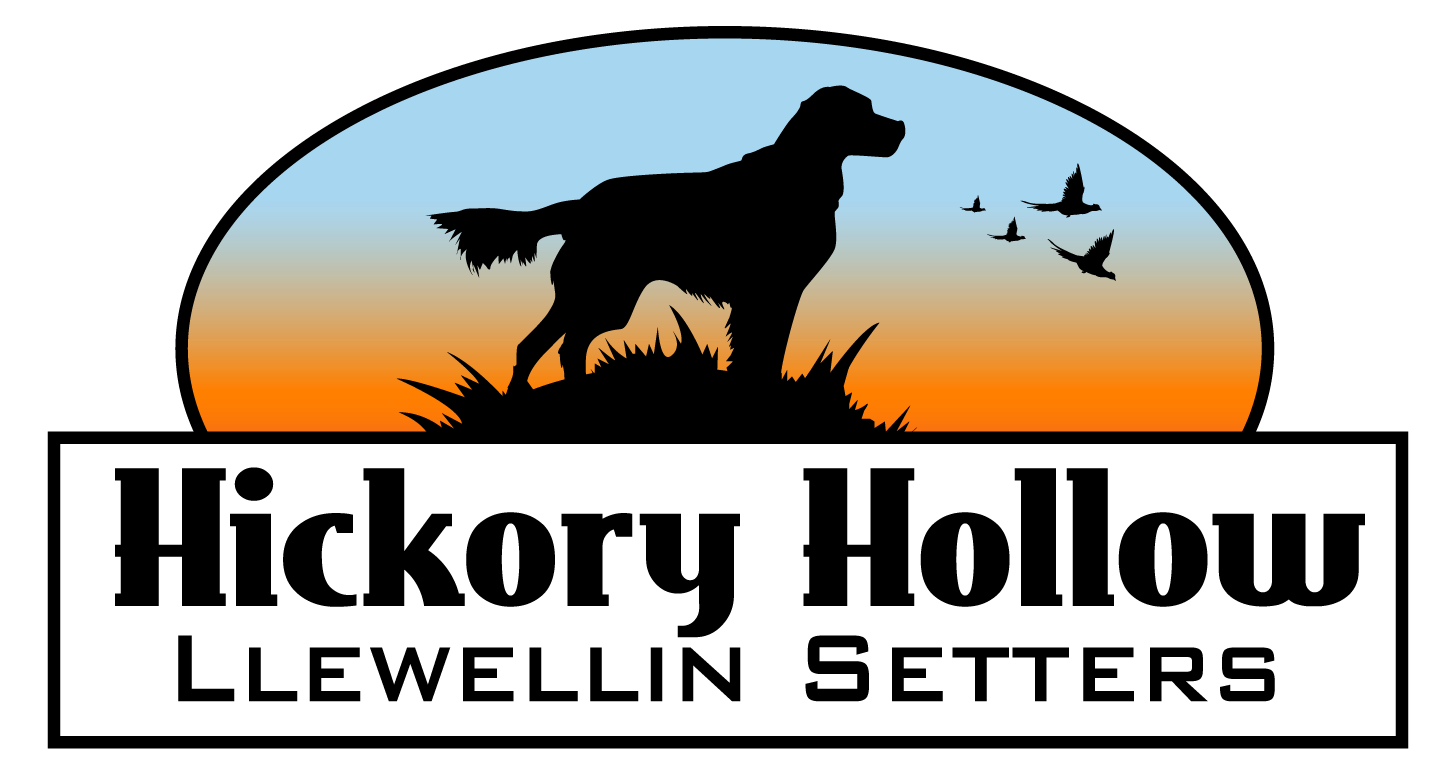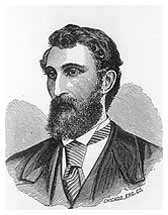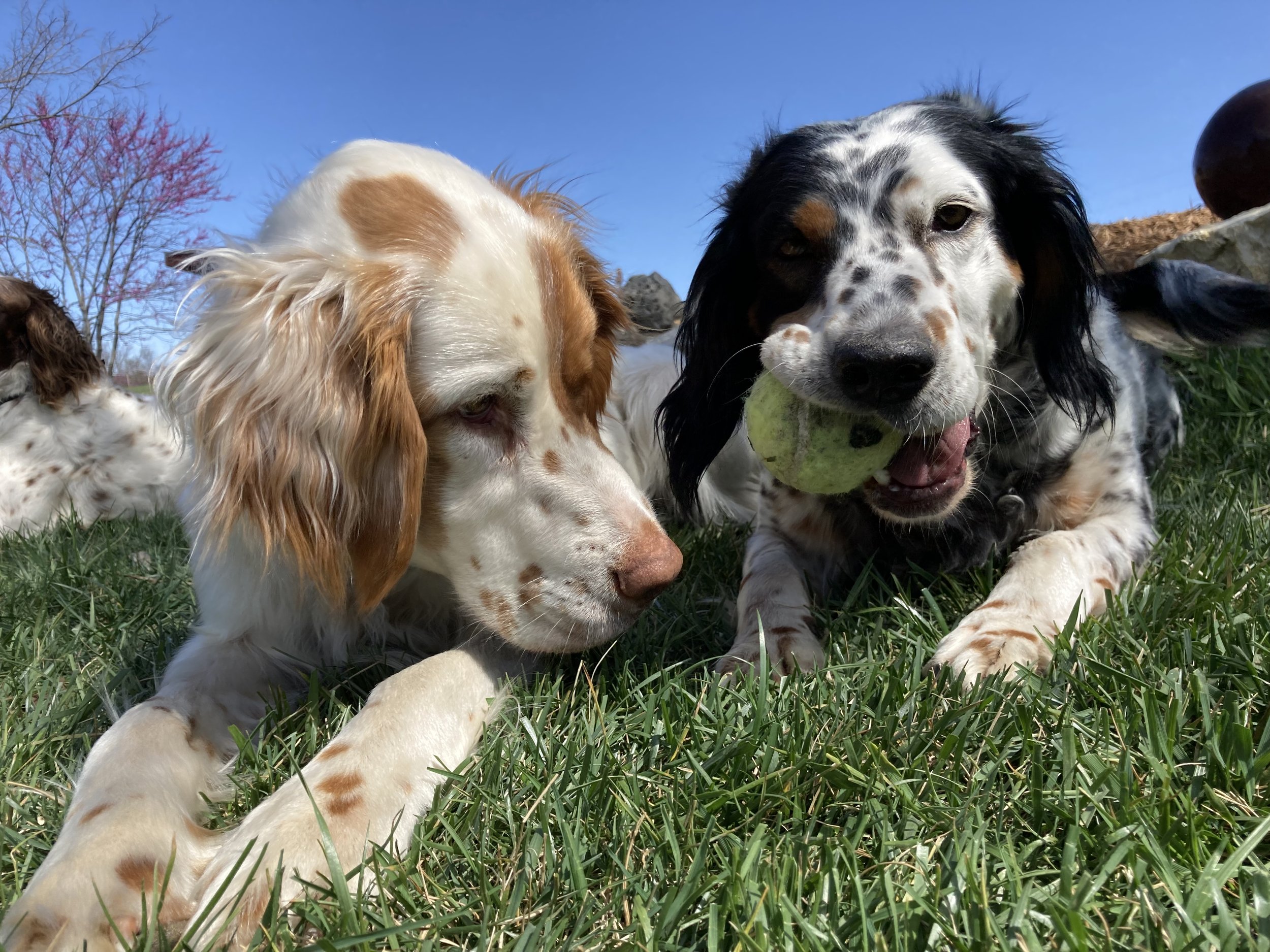
Llewellin Setter History
The breed name is spelled LLEWELLIN after the breed founder R. L. Purcell Llewellin, not 'Llewellyn', or "Luellen" which are common mistakes.
The Llewellin Setter is a very specific strain of English Setter bloodlines where the earliest references to the breed's origin can be traced back to the early 1500's.
In the early nineteenth century a man named Mr. Edward Laverack began breeding a line of English Setters for use specifically in the field. Over five decades, Mr. Laverack maintained his lines of Setters which became quite famous and also carried his name.
Mr. R. L. Purcell Llewellin was drawn to Mr. Laverack's dogs so he bought some of his best stock, crossed them with the lines he had been working on and began his own highly specific breeding program of the dogs we have come to know today as "Llewellin Setters".
Llewellin bloodlines include:
Dashing Bondhu (= Scinn Amach = Luathas)
Wind'em (= Machad = Cloncurragh = Advie (but >90% Dashing))
Bomber
Gladstone
Royacelle
Blizzard
Edward Laverack
(1797 - 1877)
R. L. Purcell Llewellin
(1840 - 1925)
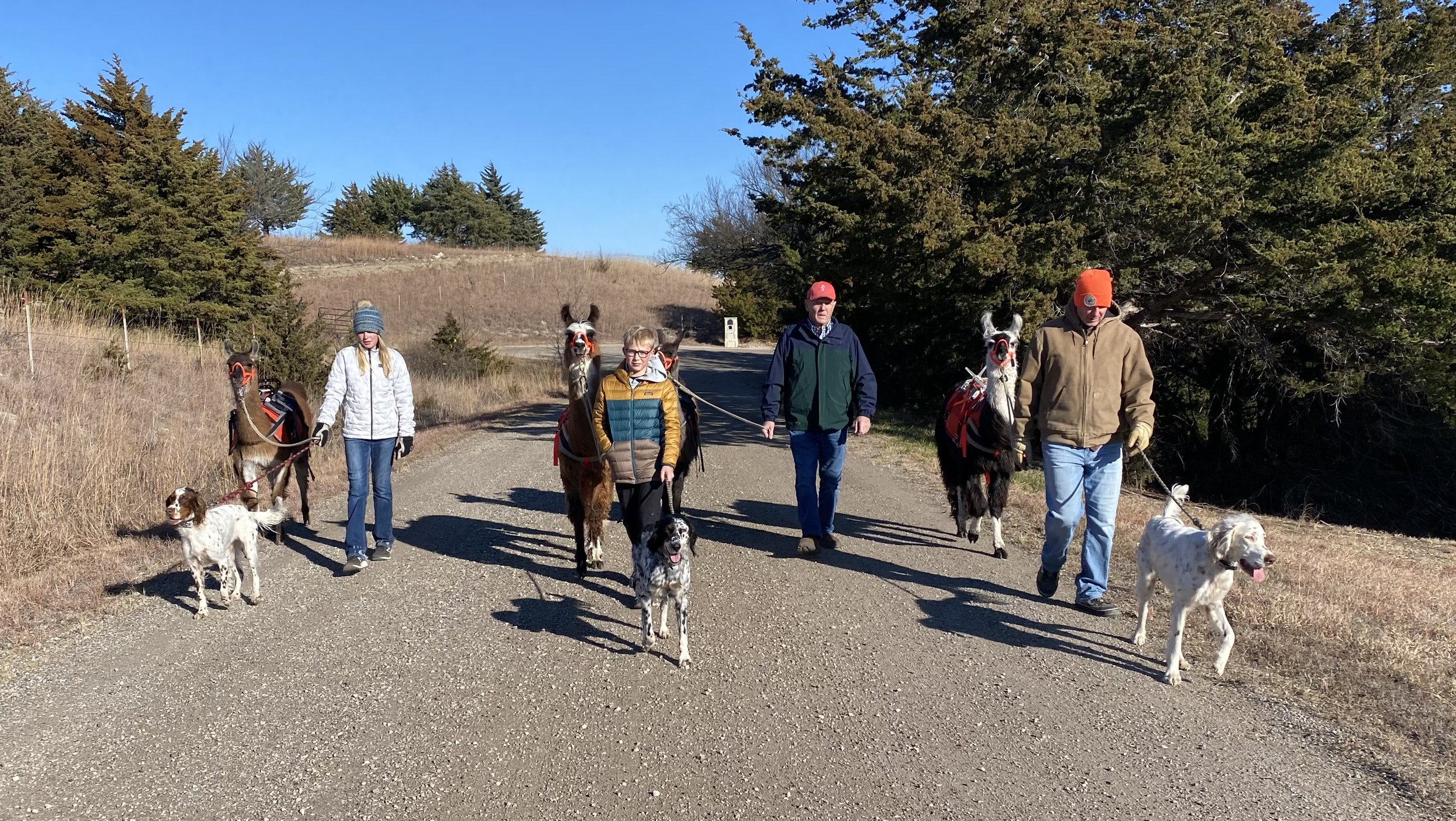
Purebred Llewellins vs "Llewellin-type" Setters
One cannot merely glance at an English Setter (ES) and say definitively the dog is indeed a “Llewellin” as you can with most other purebred dog breeds. To be a purebred Llewellin, there must be DNA proof, or "Verified Identifiable Parentage" (VIP) of Llewellin lineage showing direct ancestry to Mr. Purcell Llewellin's line of dogs (Duke-Rhoebe-Laverack) with no out-crossings (pairings with anything other than another Llewellin).
Proof of Llewellin ancestry is accomplished only through DNA testing of the dog's cheek cells and is done by The American Field (FDSB registry) in conjunction with the UC Davis Veterinary Genetics Lab.
To help clear some confusion about pure Llewellins versus "Llewellin-type" setters, we’ve provided some descriptions and illustrations.
Pure Llewellins must have VIP DNA. They have relatively the same conformation as their field-type English Setter cousins having a rounder muzzle, shorter ears, shorter coat with thinner feathers, and narrow spoon shaped feet as compared to bench-type setters, but are smaller in stature. When on point, they should hold their tail out straight from the body at a 10:00 position or higher.
ES Field Setters are often referred to as "Llewellin-type" because the Llewellin has always been known as a field setter due to their involvement in the upland hunting sport. ES field Setters are also bred for the field (unlike bench setters) and have the same overall conformation but are significantly larger than the Llewellin in stature.
Sometimes you'll hear breeders claim they have "Llewellin-type" English Setters, but more accurately what they really mean is they have "field-type" English Setters bred for hunting, which are not actually true Llewellins at all. Just because a dog is a field-type English Setter and is referred to as "Llewellin-type" does not mean the dog is a purebred Llewellin; the proof is in the DNA.
ES Bench Setters are bred for the show ring rather than the field and have completely different conformation than their field-type cousins. For instance, their coat is thicker and much longer, they have deep jowls with a square muzzle and long ears, their feet are wide and they carry their tail in line with their back.
In a nutshell... All Llewellin Setters are English Setters,
but not all English Setters are Llewellins!!
How does DNA Parentage analysis work?
"This accurate and reliable test uses state-of-the-art DNA technology, allowing canine genetic identity to be certified with a confidence of greater than 99.9%" --MMI Genomics, Inc.
The UC Davis Veterinary Genetics Lab (formerly MMI Genomics) is responsible for testing DNA swabs and verifying Llewellin Setter heritage for all American Field FDSB registered dogs so when a particular dog is tested, they can confirm the sire and dam on the registration are indeed DNA matches to that offspring. This “DNA proof” is required of breeding dogs in order to register their puppies as a Llewellin. A Llewellin may “look” exactly like a field-type English Setter, but the difference is in the DNA, breed’s history, the bloodlines and the dog’s superior performance in the field.
Disposition:
Anyone who has ever owned, trained or hunted Llewellin Setters can verify they are tops in the gun dog world. We have yet to encounter a breed which approaches the Llewellin for efficiency in the field, disposition in the home and for overall performance and temperament and here's why:
Llewellin Setters are very possibly the best of all breeds for bird hunting. They are family friendly, working gun dogs loaded with natural instincts to hunt and point birds. After hunting with different types of setters and pointers, many foot hunting sportsmen will agree this breed has the greatest nose of any hunting breed and can locate their quarry at amazing distances.
Llewellins embody the ideal blend of strength, stamina, grace and style which together comprise the best all-around sporting breed. They seem to effortlessly leap and bound about, covering an amazing amount of ground at equally amazing speed and they don't tire easily. This breed will literally hunt until they drop, so it is extremely imperative to know your dog's limits and enforce time-outs at appropriate intervals.
Llewellins are very versatile. They can go from hunting willow ptarmigan on the spongy tundras of Alaska, to prairie chicken on the open plains in Kansas and then on to grouse hunting in heavy cover in the upper peninsula of Michigan without skipping a beat. Llewellins are generally not water dogs, but with training can learn to love water retrieves so they can also be used for waterfowl hunting.
Most pups (including our dogs) display natural hunting instincts very early in life. Usually by the age of 12 weeks a person should be able to coax an instinctual point when the pup is presented with a bird wing on a line. About 50% of our pups are natural retrievers in a breed which is usually force trained to retrieve.
They are loyal, gentle, intelligent, affectionate, obedient, and enthusiastic. They have a high desire to please their owners whether in the field or in the home and tend to create a strong bond with their human companion. They crave human companionship so this is not a hunting breed which should be left outdoors in kennels their entire lives. These dogs need human interaction on a daily basis in order to thrive and to reach their full potential. These dogs can be strong-willed at times so reinforcement of training is essential.
They are excellent family dogs. Unlike many other high-strung and/or aloof hunting dog breeds, these dogs are more laid back, want to be in your company and do very well around small children and in the home. They can be excitable at times, but tend to quiet down and settle in very quickly.
Quirks:
Llewellins like to chew on their feet! (Don't ask us why, it's just a quirk!)
They drool when they are nervous or when they are staring you down begging for your food.
Young dogs tend to become carsick easily, but most grow out of this condition as adults.
Faults:
The Llewellin can sometimes need extra retrieving training as they are generally a force to retrieve breed. We have had little trouble getting our hunting Llewellins to retrieve. While not an instinctive trait, they have all learned this game with practice.
They can tend to be incessant barkers if left outside unattended for long periods of time (also another good reason not to banish them to outdoor kennels for their entire lives).
They also like to chew, so be careful about what items you leave in their company (leather shoes, remote controls, couch cushions, dog beds --they especially like to chew off the corner, stick their head inside and pull out all the stuffing!).
If you are looking for a top notch bird dog, then the Llewellin Setter deserves a long, hard look because whether you bird hunt or just need a wonderful family companion, this breed will not disappoint!
Breed Standards:
Height (at shoulder) - This measurement is usually between 22 and 24 inches. The Llewellin Setter bloodlines tend to be somewhat smaller than their English Setter counterparts. For comparison, English Setters bred for show should be around 23 to 27 inches in height.
Weight - Females run between 35 to 50 pounds. Males from 45 to 60 pounds on average.
Coat - Single-coated (no undercoat) with soft, fine, silky hair, medium to long in length. Feathering should be present on the chest, on the back of all legs, on the ears and most noticeably on the tail. Llewellin bloodlines have produced coat textures which are both smooth (flat without curl) and wavy. Shedding does occur continually, but the coat generally does not go through "seasonal" shedding periods resulting in large clumps of hair coming out all at once like you see in the double-coated breeds. More hair loss may be evident after several days out hunting in the fields as their coats are designed to pull out when running through the tall grasses so as not to capture as many seed pods, etc. This quality also makes their coat easier to rid of those parasitic giant cockleburs and their relatives alike during an after-the-hunt grooming session.
Colors - There are a wide variety of color variations in this breed which should please just about every Setter lover out there.
Style on point: Field setters hold a high tail posture, 10:00 or higher is normal. The tail should be held straight or slightly curved. Most times dogs will also lift one front paw off the ground, but it's not uncommon to see a rear foot come up once in a while, or all four feet remaining planted.
Other traits: You will notice most Llewellins have low-set ears which attach to the head at the level of the eyes, have "spoon" shaped feet and carry a high tail posture when pointing. When on the move, they carry their heads high and have lively tails. They are quick and swift on their feet and leap like gazelles through tall grasses or when on the chase after small prey (namely chipmonks or ground squirrels and other small rodents.)

Health:
Overall, Llewellin Setters are a pretty healthy breed with very few genetic problems. They do not have any known specific types of cancer in their bloodlines, which can be a characteristic linked specifically to other breeds. However, like each individual breed of canine, Llewellins do have some known health issues which are described below:
Canine Hip Dysplasia (CHD) - This hereditary condition in larger breed dogs has not escaped the Llewellin, but due to diligent breeding standards by the founders of the early American Llewellin lines, this disease has been greatly reduced in some bloodlines and is not as common of an occurrence as is displayed in their English Setter counterparts.
NOTE: OFA has recently started differentiating between the Llewellin Setter and English Setter breeds when evaluating hip scores whereas PennHIP has always done it. Early OFA certificates grouped all Llewellins with the English Setters, so those certificates will show the breed as "ES". This should not concern folks who are evaluating health certifications as to the true nature of the breed as the FDSB certificate showing registration as a purebred Llewellin should suffice.
It should soon be possible to use OFA's collected data to accurately evaluate the overall status of rates of occurrence of CHD in Llewellin Setters as well as evaluation of the PennHIP database.
Juvenile Cataracts – Some bloodlines in the Llewellin Setter have been known to be carriers of genes which cause Juvenile Cataracts. This defect occurs when a white film develops in the ocular lens which can cause blindness in relatively young dogs. Many dogs develop cataracts later in life due to the normal aging process, but this defect may show up as early as six months to one year of age. The disease does not always cause complete blindness, but can impair vision significantly and in some cases can lead to glaucoma. Make sure parents have been health tested and verify there is a family history of the lineage being free from the disease.
Hypothyroidism – The thyroid gland in the neck makes a hormone called thyroxine which controls metabolism. When a dog is hypothyroid, the gland isn't making enough of this hormone. This condition is somewhat common in dogs and is caused by impaired production and secretion of thyroid hormones and in 95% of cases occur as a result of destruction of the thyroid gland due to the dog's own immune system killing the cells in the gland. Symptoms include hair loss, dull and thin coat, flaky skin to name a few. Testing for this disease constitutes a blood draw and serum evaluation of the T4 concentration.
Deafness – Llewellins, being part of the English Setter breed, are prone to hereditary deafness. Deafness can occur unilaterally (in only one ear) or bilaterally (in both ears). The way deafness is inherited is not exactly known other than there is an association to color types. Belton dogs with less pigmentation and no body patches are more prone to deafness than non-belton and blanketed types of dogs. Deafness occurs in about 14% of the English Setter population and is even lower in the Llewellin strains. I believe this can be attributed to the fact more English Setters are belton-type dogs since this is what they are bred for to be in the show ring and to meet AKC standards. Llewellins, being field setters and far removed from the AKC standards, are more apt to have body patches. English Setters share this health issue with Dalmations for obvious reasons.
Atopic Eczema – Llewellins tend to have somewhat thin and sensitive skin as puppies and young adults. They seem to be more prone to skin related allergies at this age which can cause little red bumps all over the skin, intense itching, and redness. The dog will usually lick and nibble on the infected areas causing larger sores. Sometimes a medicated bath is all it takes to clear up the skin problem. Others may need oral or topical medication but always consult and follow the recommendations of your veterinarian. The good news is Llewellins do seemingly tend to grow out of this problematic skin stage, but problems may still develop infrequently in adult dogs as well.
Ear Infections - Since Llewellin Setters have floppy ears, the ear canal does not get air flow to it like erect-eared breeds (ie: German Shepherds or Siberian Huskies). The lack of air circulation and the warm environment of the ear canal readily aids in the growth of yeast infections which can be a common occurrence.
TIP: USE CAUTION when giving your puppy or adult dog a bath. Any water which gets down into the ear canal during bathing or swimming will most likely develop into a yeast infection.
Healthy ear canals will be light pink in color (the natural color of the skin) and have relatively little to no odor and may have very minimal waxy substance.
Infected ear canals will have a lot of dark greyish or black gunk, the skin may be red and swollen, possibly warm to the touch and will give off a foul smelling odor. If you notice any of these symptoms, get your dog to the vet for a check-up right away. The infected ear canals should initially be cleaned by a professional (so as not to puncture the ear drum) and should be treated with medicated drops for a few days. Your vet may also show you how to clean your dog’s ear canals and provide you with a liquid cleaning solution in case you should notice another problem in the future.
Training:
Llewellin Setters can be trained to hunt any kind of upland game bird, including, but not limited to, pheasant, quail, grouse, ptarmigan, chukar and other partridge. Once they get the "birdy" knack, they will transition very quickly and easily to all different types of game birds making them very versatile in the field as hunters. They can also be trained to range at any distance, with the range based purely upon an individual's preference for the type of hunting they like to do. We hunt our Llewellins over various ranges. They tend to adjust their range automatically, dependent upon the species being hunted and the terrain. This is usually accomplished over just a few hours. Fresh out of the truck on the first hunt, your dog will have an edge to run off. Just like kids, it's something they want to do and the truck ride has done nothing but get them super excited. Get your collars on them first thing and give them a little grace as they settle into their usual hunting pace.
Llewellins are very smart and are easy to train, but it can be a tricky task due to their natural birdy instincts because they can be very distracted in an outdoor environment. They are also a very sensitive breed and will not do well with harsh reprimand, so training must take a soft and positive approach. This breed can be easily discouraged and could suffer training setbacks due to fear if the wrong tactics are used. Therefore we highly recommend using a professional trainer specializing in the Llewellin Setter breed.
The following are the types of training we recommend:
Basic Obedience - The term "basic" is used to indicate the dog will obey simple commands such as "come", "sit", "down", "whoa", etc., which are usually desired as general house manners. Attending a structured obedience class to show you how to teach, and your dog how to learn, these commands is a great way to spend time and bond with your dog. This preliminary training will serve as a great foundation for any future field training you plan to do with your dog. As a side note, “whoa” and "stay" have different meanings. The "whoa" command is used to essentially stop the dog in her tracks, either to honor another dog on point, stop them from running onto a road, or any other scenario where you just need your dog to stop moving forward. The "stay" command, on the other hand, is useful if you need her to sit, lay down, or otherwise wait somewhere for you.
Gun Dog / Field Training - Even though Llewellins possess a very strong natural instinct to hunt and point birds, in order to get the perfect hunting companion, the dog must first learn to be obedient in the field, then be conditioned to the gun, and also learn the desired responses to our field commands to ultimately perform the way they are asked to. The Llewellin does not need to be taught “how to hunt”, they only need to be taught “how to respond” to the owner’s commands. Once the perfect blend of natural instinct and obedience is achieved, hunting with a Llewellin will be a highly enjoyable experience.
Grooming:
Grooming requirements of the Llewellin are as follows:
Coat: Llewellins don't require a lot of grooming due to their single layered coat, however one needs to keep an eye on their feathering as it can become matted. The best way to groom a Llewellin's coat is to brush the body with a soft bristled hair brush at least once per week to remove any debris or dirt, etc. We do not recommend the wire slicker kind of brush because the Llewellin's coat is not thick enough and the wires can scratch the skin and cause problems. The longer feathering should be combed with a wide tooth metal comb or rake to prevent matting, paying special attention to the feathering behind the ears, chest and tail.
Ears: Llewellins can have a tendency to have ear problems because of their anatomy. Ears should be checked regularly for brown waxy discharge and/or foul smell which could mean a yeast infection is brewing. Ear cleaning solution should be squirted into the ear and then the canal massaged to break up any waxy build up. Then use cotton balls to soak up the solution and wipe out the inside to remove any gunk. Yeast infections require treatment.
Toe nails Toe nails should be kept short to prevent breakage, especially with all the running they do it would be easy to get them caught on something and rip wide open. It is obviously easier to clip white toenails than black ones because you can see the quick bed inside. For white nails, stay clear of the pink quick. For black nails, start by shaving off the nail at the tip and working backwards toward the quick a little at a time until the bed starts to become soft inside. If you are uncomfortable with trimming nails yourself, ask your vet for help.
Activity Level:
Very Active:
Llewellins are performance athletes and require lots of daily exercise and a large open area with the ability to run off-leash. When they are outdoors, the majority of the time they are "on the hunt", so a large fenced enclosure where they can run and exercise as well as socialize with other dogs without the threat of harm or escape is highly recommended.
Life Expectancy:
On average, 12 years
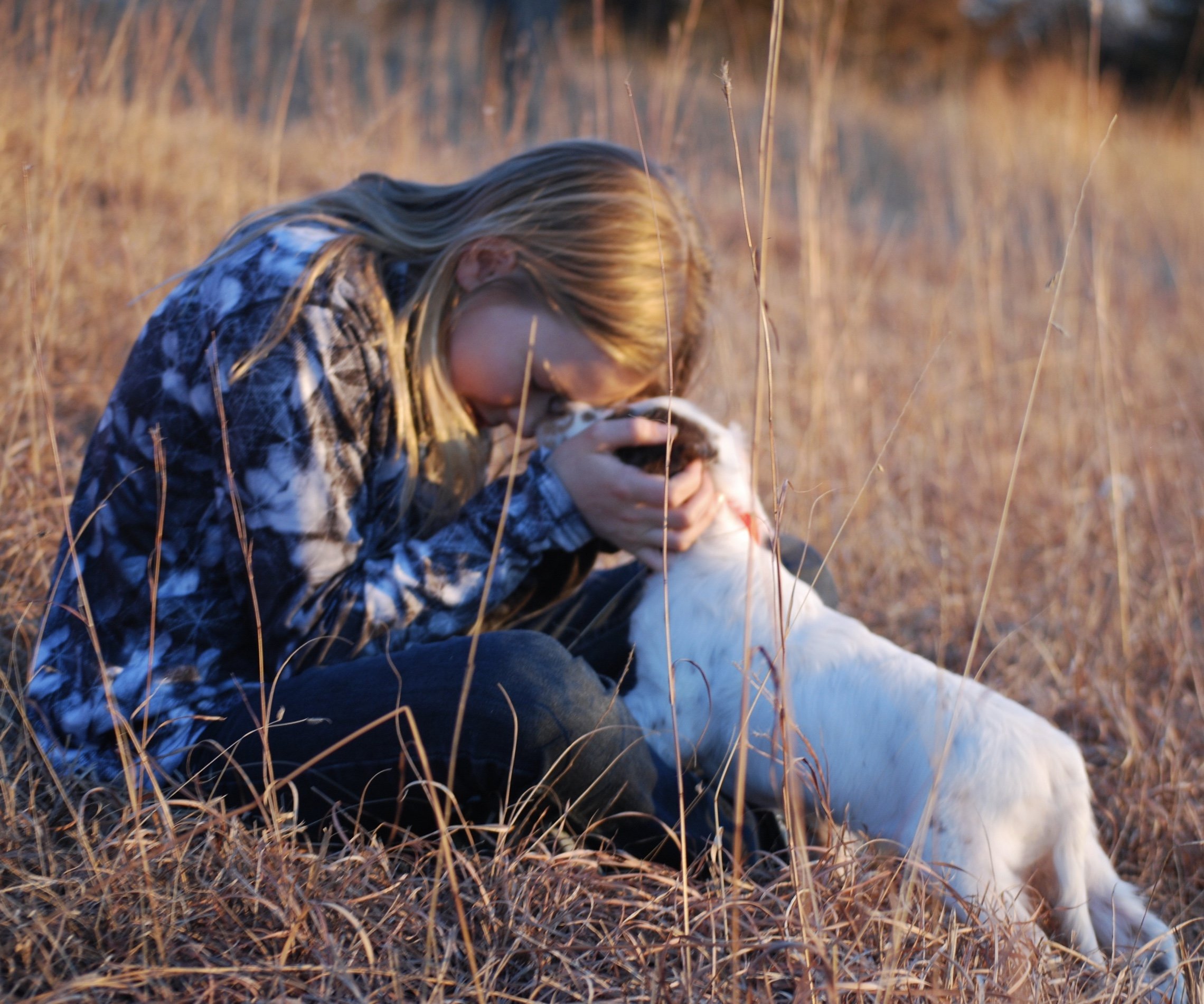
FAQ's - Frequently Asked Questions
1) Should I get a male or a female?
It really is simply a matter of personal preference. The differences are this;
Personality - males tend to be more mellow, love to be pampered, and get along well with other dogs, even males of other breeds if neutered young. Females are a little more high strung and tend to be more independent, testing their owners to see how much they can get away with (I tend to call it stubborn and headstrong). Both males and females tend to be great family companions. They will bond to a single family member, crave their attention the most, and be very protective of that person, but still love everyone in the family.
Hunting ability - males and females both have an uncanny instinctual drive to hunt, however males seem to be stronger and have more endurance for long days than females. Females tend to be the fastest right out of the gate, more cunning and stealthy, appearing to "think" about how to hunt.
2) Should I get a puppy or an adult?
Again, this is really a matter of personal preference, the timing in your life and how much extra time you have to devote to your dog.
Puppies take a lot of effort. They are constantly on the go and into everything so they need a lot of supervision. Puppies also look to you for guidance and training so you must be able to devote a lot of time to them. The good thing is, you will create a strong bond and they will be brought up learning the things you've taught them. It's a good way to mold and shape your dream dog of the future. Puppies are not recommended around toddlers because they tend to be rough and play bite a lot and can knock the child down. If you plan to have a puppy around a toddler, constant supervision is advised.
Adults are more mellow and have grown out of a lot of the puppy behaviors which require so much supervision. As a result, they will not take up as much of your time with socialization and training. However you may also be inheriting a dog with some bad habits from a previous owner. An older dog may be better around children because they have grown out of the sharp little puppy teeth and biting stage, particularly if the dog was raised around children. An older dog not raised around children may not have the same tolerance, initially, but in time may come to truly enjoy the company of children.
3) Should I get my puppy spayed or neutered?
YES! Unless you have an outstanding specimen of the breed and are willing to do what it takes to validate this, you should have your puppy spayed (females) or neutered (males) as soon as possible, preferably before the dog reaches puberty and the hormones start to flow. Spaying or Neutering is a good idea for these reasons:
reduces the risk of cancer -- removing the reproductive organs before puberty lessens the chance of ovarian and breast cancer in females and testicular cancer in males. Your male or female will not be frustrated if they are not allowed to breed, and it's not pertinent for a female to have one litter before being spayed, in fact this actually increases the risk of cancer. These are old wives tales which should be ignored at all costs.
no dealing with heat cycles or hormonal personalities -- in-tact animals can be problematic in ways you may not have even thought of. Males can be more aggressive as well as territorial and mark with urine all over your home. Females come into heat about every 6 months, so you would have to deal with the sanitation issue as well as keeping her from being bred by the sneaky little neighbor dog.
breeding a litter of puppies is a HUGE responsibility -- not only to the breed itself by ensuring your dog meets the breed standards and passes genetic health testing, but also properly rearing the little babes and having the knowledge to do so, as well as placement of the puppies in responsible homes. It is a large undertaking.
Did you know?
Did you know the dog "Hank" from the show "Hunting With Hank" on Outdoor Life Network (OLN) is a Llewellin Setter? Hank, along with his owner Dez Young travel on some wild and exciting hunting adventures. Check out his show sometime on OLN (now Versus) to see him in action!
We have been continuing Hank's bloodline starting with a 2nd generation female (granddaughter) of Hank within our breeding program! Check out the "Our Setters" page for more information.
